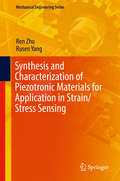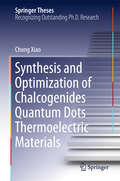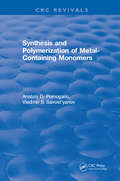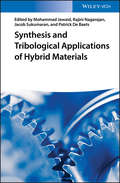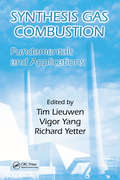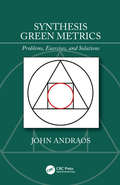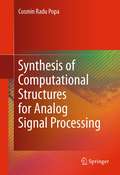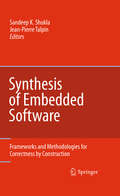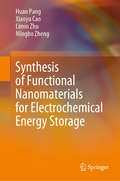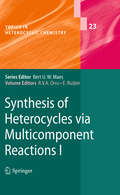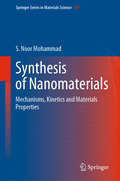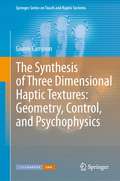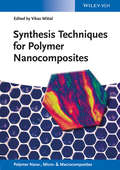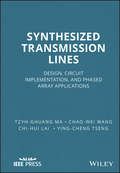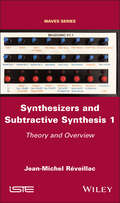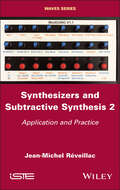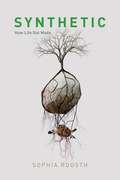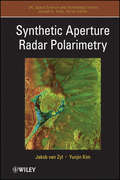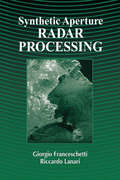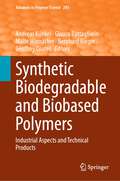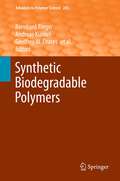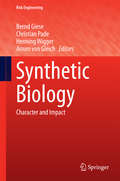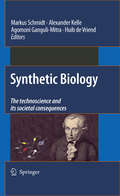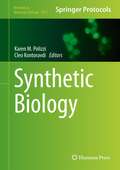- Table View
- List View
Synthesis and Characterization of Piezotronic Materials for Application in Strain/Stress Sensing
by Ren Zhu Rusen YangThis book explores the new materials and the resultant new field of piezotronics. The growth and alignment of the zinc oxide nanostructures are discussed in detail because of its wide adoption in this field and its significance in optics, health, and sensing applications. The characterization of the piezotronic effect and how to distinguish it from other similar but, fundamentally different effects, like piezoresistive effect is also considered. The huge potential in the wearable and flexible devices, as well as organic materials, is further examined. The stain/stress sensing is introduced as an example of an application with piezotronic materials.
Synthesis and Device Applications of Graphene Derivatives and Quantum Dots (Synthesis Lectures on Green Energy and Technology)
by Fangyan SunThe book explores the synthesis methods and device applications of graphene derivatives and quantum dots. The book offers a detailed overview of the synthesis techniques used for these advanced nanomaterials, including solution-phase synthesis, and surface functionalization. It delves into the unique properties and characteristics of graphene derivatives and quantum dots, highlighting their potential for revolutionizing electronic devices. The book also addresses the challenges and limitations associated with their synthesis and device integration, providing valuable insights for researchers and professionals in the field. Written by experts in the field, this book serves as a valuable resource for scientists, engineers, and students interested in exploring the vast potential of graphene derivatives and quantum dots in the development of innovative devices with enhanced performance and functionality.
Synthesis and Optimization of Chalcogenides Quantum Dots Thermoelectric Materials
by Chong XiaoThis thesis focuses onchalcogenide compoundquantum dots with special crystal structures and behaviors inan effort to achieve the synergistic optimization of electrical andthermal transport for high-efficiency thermoelectric materials. The controllability and large-scale synthesis of chalcogenide quantum dots are realizedthrough simple colloid synthesis, and the synergistic optimization of the materials' electrical and thermal transport properties is successfully achieved. Furthermore, the book exploresthe mechanism involved inthe integration of high thermoelectric performance and reversible p-nsemiconducting switching in bimetal chalcogenide semiconductors. As such, the thesis will be of interest touniversity researchers and graduate students in the materials science,chemistry and physics.
Synthesis and Polymerization of Metal-Containing Monomers
by Anatoly D. PomogailoThis book overviews methods for the synthesis of metal-containing monomers with various types of metal bonds to the organic moiety of the molecule, such as ionic, covalent, donor-acceptor, and others. Published data on homopolymerization, copolymerization, and graft polymerization of these monomers are generalized. Synthesis and Polymerization of Metal-Containing Monomers discusses features typical of the molecular and structural organization of the resulting metal-containing polymers, their properties and the associated major applications, such as catalytical and biological activity, electrophysical characteristics, and thermal resistance.
Synthesis and Tribological Applications of Hybrid Materials: Synthesis And Tribological Applications
by Mohammad Jawaid Rajini Nagarajan Jacob Sukumaran Patrick De BaetsIn-depth knowledge on tribological applications of hybrid composites Synthesis and Tribological Applications of Hybrid Materials provides a comprehensive overview of tribological properties of hybrid composites. The book offers an understanding of the processes, materials, techniques and mechanisms related to the tribological concepts and includes information on the most recent developments in the field. With contributions from an international panel of experts, the book discusses the synthesis and characterization of hybrid materials, as well as their applications in biotechnological and biomedical fields. The book covers a wide-range of versatile topics such as: Tribological assessment on accelerated aging bones in polymeric condition; Nano fracture and wear testing on natural bones; Tribological behaviour of glass fiber with fillers reinforced hybrid polymer composites and jute/glass hybrid composites; Wear properties of glass fiber hybrid, and acid- and silane-modified CNT filled hybrid glass/kenaf epoxy composites; Hybrid natural fibre composites as a friction material; and much more. This important resource: -Discusses recent advancements in the field of tribology and hybrid materials -Offers a guide for professionals in the fields of materials science, mechanical engineering, biomaterials, chemistry, physics and nanotechnology -Integrates theory, synthesis and properties of nybrid materals as well as their applications -Offers an outlook to the future of this burgeoning technology Written for materials scientists, surface chemists, bioengineers, mechanical engineers, engineering scientists and chemical industry professionals, Synthesis and Tribological Applications of Hybrid Materials is a comprehensive resource that explores the most recent developments in the field.
Synthesis Gas Combustion: Fundamentals and Applications
by Tim C. Lieuwen Vigor Yang Richard YetterCoal, still used to generate more than half of the electric power in the U.S., will likely be part of any future global energy plan. But this finite resource is also responsible for 80 percent of the CO2 emissions from power production, and its continued use will require improved processing techniques that are less damaging to the environment and l
Synthesis Green Metrics: Problems, Exercises, and Solutions
by John AndraosGreen chemistry promotes improved syntheses as an intellectual endeavour that can have a great impact both on preserving and utilizing our planet’s finite resources and the quality of human life. This masterful accomplishment provides an evaluation of environmental impact metrics according to life cycle assessment analysis based on the Mackay compartment environmental model and Guinée environmental impact potentials formalism. Assumptions, limitations, and dealing with missing data are addressed. Best literature resources for finding key toxicological parameters are provided and applied to individual reactions as well as entire synthesis plans, in order to target molecules of interest.
Synthesis of Computational Structures for Analog Signal Processing
by Cosmin Radu PopaSynthesis of Computational Structures for Analog Signal Processing focuses on analysis and design of analog signal processing circuits. The author presents a multitude of design techniques for improving the performances of analog signal processing circuits, and proposes specific implementation strategies that can be used in CMOS technology. The author's discussion proceeds from the perspective of signal processing as it relates to analog. Included are coverage of low-power design, portable equipment, wireless nano-sensors and medical implantable devices. The material is especially appropriate for researchers and specialists in the area of analog and mixed-signal CMOS VLSI design, as well as postgraduate or Ph.D. students working on analog microelectronics.
Synthesis of Embedded Software
by Jean-Pierre Talpin Sandeep Kumar ShuklaEmbedded software is ubiquitous today. There are millions of lines of embedded code in smart phones, and even more in systems responsible for automotive control, avionics control, weapons control and space missions. Some of these are safety-critical systems whose correctness, timely response, and reliability are of paramount importance. These requirement pose new challenges to system designers. This necessitates that a proper design science, based on "constructive correctness" be developed. Correct-by-construction design and synthesis of embedded software is done in a way so that post-development verification is minimized, and correct operation of embedded systems is maximized. This book presents the state of the art in the design of safety-critical, embedded software. It introduced readers to three major approaches to specification driven, embedded software synthesis/construction: synchronous programming based approaches, models of computation based approaches, and an approach based on concurrent programming with a co-design focused language. It is an invaluable reference for practitioners and researchers concerned with improving the product development life-cycle.
Synthesis of Functional Nanomaterials for Electrochemical Energy Storage
by Huan Pang Xiaoyu Cao Limin Zhu Mingbo ZhengThis book provides a comprehensive review of functional nanomaterials for electrochemical applications, presenting interesting examples of nanomaterials with different dimensions and their applications in electrochemical energy storage. It also discusses the synthesis of functional nanomaterials, including quantum dots; one-dimensional, two-dimensional and three-dimensional nanostructures; and advanced nanocomposites. Highlighting recent advances in current electrochemical energy storage hotpots: lithium batteries, lithium-ion batteries, sodium-ion batteries, other metal-ion batteries, halogen ion batteries, and metal–gas batteries, this book will appeal to readers in the various fields of chemistry, material science and engineering.
Synthesis of Heterocycles via Multicomponent Reactions II
by Eelco Ruijter Romano V. OrruGéraldine Masson, Luc Neuville Carine Bughin Aude Fayol Jieping Zhu Multicomponent Syntheses of Macrocycles Thomas J.J. Müller Palladium-Copper Catalyzed Alkyne Activation as an Entry to Multicomponent Syntheses of Heterocycles Rachel Scheffelaar Eelco Ruijter Romano V.A. Orru Multicomponent Reaction Design Strategies: Towards Scaffold and Stereochemical Diversity Nicola Kielland Rodolfo Lavilla Recent Developments in Reissert-Type Multicomponent Reactions Jitender B. Bariwal Jalpa C. Trivedi Erik V. Van der Eycken Microwave Irradiation and Multicomponent Reactions Irini Akritopoulou-Zanze Stevan W. Djuric Applications of MCR-Derived Heterocycles in Drug Discovery
Synthesis of Nanomaterials: Mechanisms, Kinetics and Materials Properties (Springer Series in Materials Science #307)
by S. Noor MohammadThis book deals with the synthesis of nanomaterials with a strong focus on the underlying reaction kinetics and various synthesis mechanisms. It gives a detailed description of all major synthesis routes of many types of novel nanomaterials including nanowires, carbon nanotubes, semiconductor nanotubes, carbon nanobelts, nanofibers, nanorings, nanodots and quantum dots. In addition, it articulates the fundamental mechanisms of nanomaterials synthesis via vapor-phase, liquid-phase and solid-phase processes, highlighting the various strengths and weaknesses of each mechanism. This monograph provides the reader with a thorough review of the known state-of-the-art, along with a detailed comparison and analysis of all possible nanomaterials synthesis mechanisms. An important element of the book is how to obtain critical knowledge for controlling the morphology of nanomaterials and thereby fine tune their materials properties. The book is an ideal guide for graduate students and researchers new to the field seeking to establish or enhance their understanding of the physical and chemical fundamentals of nanomaterials synthesis mechanisms.
The Synthesis of Three Dimensional Haptic Textures: Geometry, Control, and Psychophysics
by Gianni CampionThe sense of touch is fundamental during the interaction between humans and their environment; in virtual reality, objects are created by computer simulations and they can be experienced through haptic devices. In this context haptic textures are fundamental for a realistic haptic perception of virtual objects.This book formalizes the specific artefacts corrupting the rendering of virtual haptic textures and offers a set of simple conditions to guide haptic researchers towards artefact-free textures. The conditions identified are also extremely valuable when designing psychophysical experiments and when analyzing the significance of the data collected. The Synthesis of Three Dimensional Haptic Textures, Geometry, Control, and Psychophysics examines the problem of rendering virtual haptic textures with force feedback devices. The author provides an introduction to the topic of haptic textures that covers the basics of the physiology of the skin, the psychophysics of roughness perception, and the engineering challenges behind haptic textures rendering. The book continues with the presentation of a novel mathematical framework that characterizes haptic devices, texturing algorithms and their ability to generate realistic haptic textures. Finally, two psychophysical experiments link the perception of roughness with the parameters of the haptic rendering algorithms. This book formalizes the specific artefacts corrupting the rendering of virtual haptic textures and offers a set of simple conditions to guide haptic researchers towards artefact-free textures. The conditions identified are also extremely valuable when designing psychophysical experiments and when analyzing the significance of the data collected.
Synthesis Techniques for Polymer Nanocomposites
by Vikas MittalSummarizing all the most important synthesis techniques used in the lab as well as in industry, this book is comprehensive in its coverage from chemical, physical and mechanical viewpoints.In a self-contained manner, the text guides readers in choosing the correct synthesis routes, such as suspension and miniemulsion polymerization, living polymerization, sonication, mechanical methods or the use of radiation, and so achieve the desired composite properties.
Synthesized Transmission Lines: Design, Circuit Implementation, and Phased Array Applications
by Chao-Wei Wang Chi-Hui Lai Tzyh-Ghuang Ma Ying-Cheng TsengAn original advanced level reference appealing to both the microwave and antenna communities * An overview of the research activity devoted to the synthesis of transmission lines by means of electrically small planar elements, highlighting the main microwave applications and the potential for circuit miniaturization* Showcases the research of top experts in the field* Presents innovative topics on synthesized transmission lines, which represent fundamental elements in microwave and mm-wave integrated circuits, including on-chip integration* Covers topics that are related to the microwave community (transmission lines), and topics that are related to the antenna community (phased arrays), broadening the readership appeal
Synthesizers and Subtractive Synthesis 1: Theory and Overview
by Jean-Michel RéveillacSubtractive sound synthesis has been one of the most widely used techniques in electronic music and for many analog synthesizers since the early 1960s. It is based on a simple principle, but its operation remains complex, involving many parameters. It can be enriched by a variety of effects that give the sound its authenticity. It does not just imitate musical instruments, but can also transcribe noises present in natural soundscapes, or generate entirely synthetic sounds. Synthesizers and Subtractive Synthesis 1 presents the theoretical basis of a sound phenomenon, the different types of synthesis, the components that are required and present in synthesizers, the working environment specific to the study of subtractive synthesis, and the hardware and software available. After reading the various chapters of this book, readers will have a clear vision of the tools and actions required to grasp the world of subtractive sound.
Synthesizers and Subtractive Synthesis, Volume 2: Application and Practice
by Jean-Michel RéveillacSubtractive sound synthesis is one of the most widely used techniques in electronic music and in many analog synthesizers since the early 1960s. It is based on a simple principle, but its operation is complex, involving many parameters. It can be enhanced by a variety of effects that give the sound its authenticity, and does not simply imitate musical instruments, but can also transcribe noises present in natural soundscapes or generate entirely synthetic sounds. Synthesizers and Subtractive Sound Synthesis 2 presents practical exercises, ranging from the fundamentals to advanced functionalities. Most of the sound effects applicable to subtractive synthesis are covered: vibrato, phaser, reverb, etc. The final chapters deal with polyphony and arpeggiator-sequences.
Synthetic: How Life Got Made
by Sophia RoosthIn the final years of the twentieth century, émigrés from engineering and computer science devoted themselves to biology and resolved that if the aim of biology is to understand life, then making life would yield better theories than experimentation. Armed with the latest biotechnology techniques, these scientists treated biological media as elements for design and manufacture: viruses named for computers, bacterial genomes encoding passages from James Joyce, chimeric yeast buckling under the metabolic strain of genes harvested from wormwood, petunias, and microbes from Icelandic thermal pools. In Synthetic: How Life Got Made, cultural anthropologist Sophia Roosth reveals how synthetic biologists make new living things in order to understand better how life works. The first book-length ethnographic study of this discipline, Synthetic documents the social, cultural, rhetorical, economic, and imaginative transformations biology has undergone in the post-genomic age. Roosth traces this new science from its origins at MIT to start-ups, laboratories, conferences, and hackers’ garages across the United States—even to contemporary efforts to resurrect extinct species. Her careful research reveals that rather than opening up a limitless new field, these biologists’ own experimental tactics circularly determine the biological features, theories, and limits they fasten upon. Exploring the life sciences emblematic of our time, Synthetic tells the origin story of the astonishing claim that biological making fosters biological knowing.
Synthetic Aperture Radar Polarimetry
by Jakob Van Zyl Yunjin KimThis book describes the application of polarimetric synthetic aperture radar to earth remote sensing based on research at the NASA Jet Propulsion Laboratory (JPL). This book synthesizes all current research to provide practical information for both the newcomer and the expert in radar polarimetry. The text offers a concise description of the mathematical fundamentals illustrated with many examples using SAR data, with a main focus on remote sensing of the earth. The book begins with basics of synthetic aperture radar to provide the basis for understanding how polarimetric SAR images are formed and gives an introduction to the fundamentals of radar polarimetry. It goes on to discuss more advanced polarimetric concepts that allow one to infer more information about the terrain being imaged. In order to analyze data quantitatively, the signals must be calibrated carefully, which the book addresses in a chapter summarizing the basic calibration algorithms. The book concludes with examples of applying polarimetric analysis to scattering from rough surfaces, to infer soil moisture from radar signals.
Synthetic Aperture Radar Processing
by Giorgio Franceschetti Riccardo LanariSynthetic Aperture Radar Processing simply and methodically presents principles and techniques of Synthetic Aperture Radar (SAR) image generation by analyzing its system transfer function. The text considers the full array of operation modes from strip to scan, emphasizes processing techniques, enabling the design of operational SAR codes. A simple example then follows.This book will be invaluable to all SAR scientists and engineers working in the field. It may be used as the basis for a course on SAR image generation or as a reference book on remote sensing. It contains a wide spectrum of information presented with clarity and rigor.
Synthetic Biodegradable and Biobased Polymers: Industrial Aspects and Technical Products (Advances in Polymer Science #293)
by Andreas Künkel Glauco Battagliarin Malte Winnacker Bernhard Rieger Geoffrey CoatesThis volume presents the recent developments in synthetic biodegradable and biobased polymers. The syntheses of many polymer types such as polyesters and polyamides, and also their processing technologies are discussed herein, and new aspects from fundamental and from industrial research are covered. This combination of both perspectives within this volume will be of interest for many research scientists from academia and industry and also for lectures and teachers. Chapters ''BioPBSTM (Polybutylene succinate)'' and ''Polymer biodegradability 2.0: A holistic view on polymer biodegradation in natural and engineered environments'' are available open access under a Creative Commons Attribution 4.0 International License via link.springer.com. For further details see license information in the chapter.
Synthetic Biodegradable Polymers
by Andreas Künkel Robert Reichardt Bernhard Rieger Geoffrey W. Coates Eckhard Dinjus Thomas A. ZevacoSalen Metal Complexes as Catalysts for the Synthesis of Polycarbonates from Cyclic Ethers and Carbon Dioxide, by Donald J. Darensbourg.- Material Properties of Poly(Propylene Carbonates), by Gerrit. A. Luinstra and Endres Borchardt.- Poly(3-Hydroxybutyrate) from Carbon Monoxide, by Robert Reichardt and Bernhard Rieger. - Ecoflex® and Ecovio®: Biodegradable, Performance-Enabling Plastics, by K. O. Siegenthaler, A. Künkel, G. Skupin and M. Yamamoto.- Biodegradability of Poly(Vinyl Acetate) and Related Polymers, by Manfred Amann and Oliver Minge.- Recent Developments in Ring-Opening Polymerization of Lactones, by P. Lecomte and C. Jérôme.- Recent Developments in Metal-Catalyzed Ring-Opening Polymerization of Lactides and Glycolides: Preparation of Polylactides, Polyglycolide, and Poly(lactide-co-glycolide), by Saikat Dutta, Wen-Chou Hung, Bor-Hunn Huang and Chu-Chieh Lin.- Bionolle (Polybutylenesuccinate), by Yasushi Ichikawa, Tatsuya Mizukoshi.- Polyurethanes from Renewable Resources, by David A. Babb.-
Synthetic Biology
by Bernd Giese Christian Pade Henning Wigger Arnim Von GleichSynthetic Biology is already an object of intensive debate. However, to a great extent the discussion to date has been concerned with fundamental ethical, religious and philosophical questions. By contrast, based on an investigation of the field's scientific and technological character, this book focuses on new functionalities provided by synthetic biology and explores the associated opportunities and risks. Following an introduction to the subject and a discussion of the most central paradigms and methodologies, the book provides an overview of the structure of this field of science and technology. It informs the reader about the current stage of development, as well as topical problems and potential opportunities in important fields of application. But not only the science itself is in focus. In order to investigate its broader impact, ecological as well as ethical implications will be considered, paving the way for a discussion of responsibilities in the context of a field at a transitional crossroads between basic and applied science. In closing, the requirements for a suitable regulatory framework are discussed. The book is intended as a source of information and orientation for researchers, students and practitioners in the natural sciences and technology assessment; for members of scientific and technological, governmental and funding institutions; and for members of the general public interested in essential information on the current status, prospects and implications of synthetic biology.
Synthetic Biology
by Alexander Kelle Markus Schmidt Agomoni Ganguli-Mitra Huib De VriendSynthetic biology is becoming one of the most dynamic new fields of biology, with the potential to revolutionize the way we do biotechnology today. By applying the toolbox of engineering disciplines to biology, a whole set of potential applications become possible ranging very widely across scientific and engineering disciplines. Some of the potential benefits of synthetic biology, such as the development of low-cost drugs or the production of chemicals and energy by engineered bacteria are enormous. There are, however, also potential and perceived risks due to deliberate or accidental damage. Also, ethical issues of synthetic biology just start being explored, with hardly any ethicists specifically focusing on the area of synthetic biology. This book will be the first of its kind focusing particularly on the safety, security and ethical concerns and other relevant societal aspects of this new emerging field. The foreseen impact of this book will be to stimulate a debate on these societal issues at an early stage. Past experiences, especially in the field of GM-crops and stem cells, have shown the importance of an early societal debate. The community and informed stakeholders recognize this need, but up to now discussions are fragmentary. This book will be the first comprehensive overview on relevant societal issues of synthetic biology, setting the scene for further important discussions within the scientific community and with civil society.
Synthetic Biology
by Karen M. Polizzi Cleo KontoravdiIn Synthetic Biology, expert researchers in the field provide the latest developments in molecular biology techniques used in Synthetic Biology. Focusing on computational tools that will aid in systematising the design and construction of parts and systems. Written in the highly successful Methods in Molecular BiologyTM series format, chapters include introductions to their respective topics, lists of the necessary materials and reagents, step-by-step, readily reproducible laboratory protocols, and key tips on troubleshooting and avoiding known pitfalls. Authoritative and practical, Synthetic Biology seeks to aid scientists in the further study of developing new biological components and systems.
